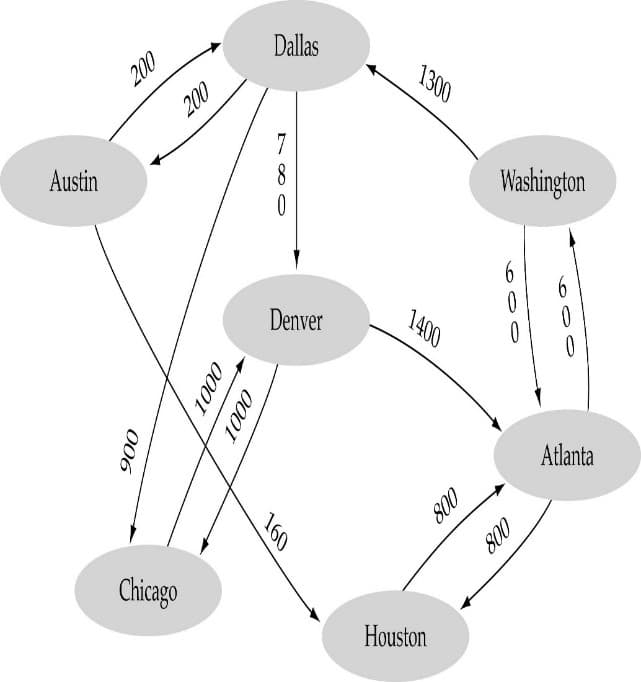Find Path (Given source and destination) Path Cost (Given source and destination)
Hello i need help with my data structure project in c++:
the requirement is that I have to
- Find Path (Given source and destination)
- Path Cost (Given source and destination)
Using the image attached.
this is my program I have done so far:
Main.cpp
#include <iostream>
#include "Data.h"
using namespace std;
int main()
{
int ch;
Graph g(0);
cout << "Graph Operations" << endl << endl;
cout << "1-2 Create Graph" << endl;
cout << "[1] Adjacency List" << endl;
cout << "[2] Adjacency Matrix" << endl << endl;
cout << "3-4 Graph Traversal" << endl << endl;
cout << "[3] BFS Traversal" << endl;
cout << "[4] DFS Traversal" << endl << endl;
cout << "5-6 Find Path/Cost" << endl << endl;
cout << "[5] Find Path (Given source and destination) " << endl;
cout << "[6] Path Cost (Given source and destination) " << endl;
cout << "[0] Close Program" << endl;
cout << "Enter choice: ";
cin >> ch;
if (ch == 1)
{
g.addEdge(0, 5);
g.addEdge(0, 6);
g.addEdge(1, 3);
g.addEdge(1, 5);
g.addEdge(2, 4);
g.addEdge(3, 1);
g.addEdge(3, 2);
g.addEdge(3, 4);
g.addEdge(4, 0);
g.addEdge(4, 2);
g.addEdge(5, 0);
g.addEdge(6, 0);
g.addEdge(6, 3);
g.printGraph();
cout << endl << endl;
}
else if (ch == 2)
{
g.addEdge2(0, 5);
g.addEdge2(0, 6);
g.addEdge2(1, 3);
g.addEdge2(1, 5);
g.addEdge2(2, 4);
g.addEdge2(3, 1);
g.addEdge2(3, 2);
g.addEdge2(3, 4);
g.addEdge2(4, 0);
g.addEdge2(4, 2);
g.addEdge2(5, 0);
g.addEdge2(6, 0);
g.addEdge2(6, 3);
g.printGraph2();
}
else if (ch == 3)
{
int j;
cout << endl << "BFS Traversal..." << endl;
cout << "Input your prefered source / start: ";
cin >> j;
cout << endl;
g.BFS(j);
}
else if (ch == 4)
{
int k;
cout << endl << "DFS Traversal..." << endl;
cout << "Input your prefered source / start: ";
cin >> k;
cout << endl;
g.DFS(k);
}
cout << endl << endl;
}
data.h
#pragma once
#include <list>
#include <iostream>
using namespace std;
class Graph
{
private:
int V;
list <int> *adj;
int **adj2;
void DFSUtil(int v, bool visited[]);
void BFSUtil(int s, bool visited[]);
public:
Graph(int);
void addEdge(int u, int v);
void addEdge2(int u, int v);
void printGraph();
void printGraph2();
void DFS(int v);
void BFS(int s);
};
implementation.cpp
#include <iostream>
#include <list>
#include "Data.h"
using namespace std;
Graph::Graph(int x)
{
V = x;
adj = new list <int> [V];
adj2 = new int* [V];
for (int i = 0; i < V; i++)
adj2[i] = new int[V];
for (int i = 0; i < V; i++)
for (int j = 0; j < V; j++)
adj2[i][j] = 0;
}
void Graph::addEdge(int u, int v)
{
adj[u].push_back(v);
}
void Graph::addEdge2(int u, int v)
{
adj2[u][v] = 1;
}
// A utility function to print the adjacency list
// representation of graph
void Graph::printGraph()
{
cout << "Adjacency List..." << endl;
for (int v = 0; v < V; ++v)
{
cout << "V[" << v << "]";
for (auto x : adj[v])
cout << " -> " << x;
cout << endl;
}
}
void Graph::printGraph2()
{
cout << "Adjacency Matrix..." << endl << endl;
cout << "\t";
for (int i = 0; i < V; i++)
cout << "V[" << i << "]" << "\t";
cout << endl;
for (int i=0; i<V; i++)
{
cout << "V[" << i << "]" << "\t";
for (int j = 0; j < V; j++)
cout << adj2[i][j] << "\t";
cout << endl;
}
cout << endl;
}
void Graph::DFSUtil(int v, bool visited[])
{
// Mark the current node as visited and
// print it
visited[v] = true;
cout << v << " ";
// Recur for all the vertices adjacent
// to this vertex
list<int>::iterator i;
for (i = adj[v].begin(); i != adj[v].end(); ++i)
if (!visited[*i])
DFSUtil(*i, visited);
}
// DFS traversal of the vertices reachable from v.
// It uses recursive DFSUtil()
void Graph::DFS(int v)
{
// Mark all the vertices as not visited
bool *visited = new bool[V];
for (int i = 0; i < V; i++)
visited[i] = false;
// Call the recursive helper function
// to print DFS traversal
DFSUtil(v, visited);
for(int i=0; i< V; i++)
if (!visited[i])
DFSUtil(i, visited);
for (int i = 0; i < V; i++)
if (!visited[i])
cout << i << " ";
}
void Graph::BFS(int s)
{
// Mark all the vertices as not visited
bool *visited = new bool[V];
for (int i = 0; i < V; i++)
visited[i] = false;
BFSUtil(s, visited);
for (int i = 0; i < V; i++)
if (!visited[i])
BFSUtil(i, visited);
for (int i = 0; i < V; i++)
if (!visited[i])
cout << i << " ";
}
void Graph::BFSUtil(int s, bool visited[])
{
// Create a queue for BFS
list<int> queue;
// Mark the current node as visited and enqueue it
visited[s] = true;
queue.push_back(s);
// 'i' will be used to get all adjacent
// vertices of a vertex
list<int>::iterator i;
while (!queue.empty())
{
// Dequeue a vertex from queue and print it
s = queue.front();
cout << s << " ";
queue.pop_front();
// Get all adjacent vertices of the dequeued
// vertex s. If a adjacent has not been visited,
// then mark it visited and enqueue it
for (i = adj[s].begin(); i != adj[s].end(); ++i)
{
if (!visited[*i])
{
visited[*i] = true;
queue.push_back(*i);
}
}
}
}
can someone show me how to find the path and path cost
![(a)
Pointer
Index of
edge nodes
Weight
to next
adjacent vertex
edge node
graph
[0] |"Atlanta
5
800
6.
600
[1] "Austin
3
200
160 /
[2] "Chicago
4 1000
[3] "Dallas
1
200
2
900
4
780
[4] "Denver
0 1400
2 1000 /
[5] "Houston
800
[6] "Washington"
3 1300
600
[7]
[8]
[9]](/v2/_next/image?url=https%3A%2F%2Fcontent.bartleby.com%2Fqna-images%2Fquestion%2Fe3e3f532-9526-4f17-b503-a9c6e956db61%2Faee7e5e1-6c9f-4030-8c91-33e0b9ba867a%2Fd9lrzxt_processed.jpeg&w=3840&q=75)

Trending now
This is a popular solution!
Step by step
Solved in 6 steps with 6 images


